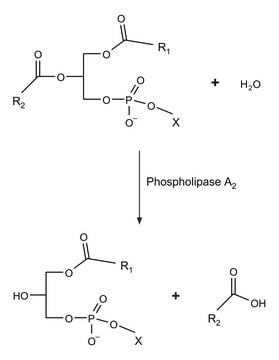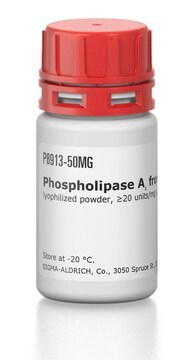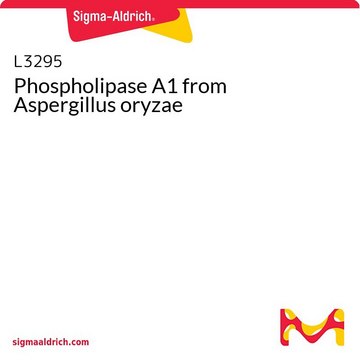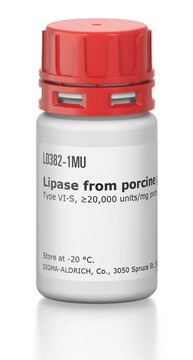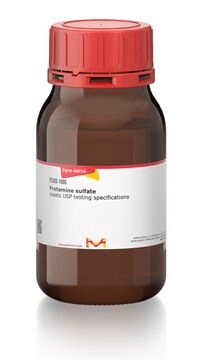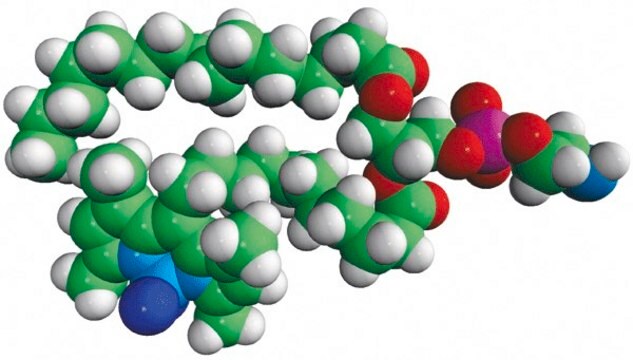Alle Fotos(1)
Wichtige Dokumente
P6534
Phospholipase A2 aus Schweinepankreas
ammonium sulfate suspension, ≥600 units/mg protein
Synonym(e):
Lecithinase A, PLA2
Anmeldenzur Ansicht organisationsspezifischer und vertraglich vereinbarter Preise
Alle Fotos(1)
About This Item
Empfohlene Produkte
Form
ammonium sulfate suspension
Spezifische Aktivität
≥600 units/mg protein
UniProt-Hinterlegungsnummer
Lagertemp.
2-8°C
Angaben zum Gen
pig ... PLA2G1B(445525)
Suchen Sie nach ähnlichen Produkten? Aufrufen Leitfaden zum Produktvergleich
Allgemeine Beschreibung
Phospholipase A2 is a small disulfide-rich protein having 124 residues. It is a calcium-dependent enzyme.
Anwendung
Phospholipase A2 has been used in phospholipase assay and to determine rat renal proximal tubular segments (PTS) viability during oxygenation and hypoxia-reoxygenation.
Biochem./physiol. Wirkung
Hydrolyzes the β-ester bond of zwitterionic glycerophospholipids. Preferred substrates are phosphatidylcholine, phosphatidylethanolamine, and their plasmalogen analogues. Phosphatidylinositol and phosphatidylserine are also hydrolyzed. Aggressively attacks phospholipids in membranes of intact cells.
It has a high catalytic activity on aggregated substrates compared to monomeric substrates.
Einheitendefinition
1 U hydrolysiert 1.0 μmol Soja L-α-Phosphatidylcholin zu L-α-Lysophosphatidylcholin und Fettsäure pro Minute bei pH 8.0 und 37 °C.
Physikalische Form
Suspension in 3.2 M (NH4)2SO4-Lösung, pH 5.5
Hinweis zur Analyse
Proteingehalt mittels Biuret-Reaktion bestimmt.
Inhibitor
Produkt-Nr.
Beschreibung
Preisangaben
Lagerklassenschlüssel
11 - Combustible Solids
WGK
WGK 1
Flammpunkt (°F)
Not applicable
Flammpunkt (°C)
Not applicable
Hier finden Sie alle aktuellen Versionen:
Besitzen Sie dieses Produkt bereits?
In der Dokumentenbibliothek finden Sie die Dokumentation zu den Produkten, die Sie kürzlich erworben haben.
Kunden haben sich ebenfalls angesehen
B van den Berg et al.
The EMBO journal, 14(17), 4123-4131 (1995-09-01)
The lipolytic enzyme phospholipase A2 (PLA2) is involved in the degradation of high-molecular weight phospholipid aggregates in vivo. The enzyme has very high catalytic activities on aggregated substrates compared with monomeric substrates, a phenomenon called interfacial activation. Crystal structures of
Knut Kölbel et al.
Biophysical chemistry, 206, 12-21 (2015-06-29)
Porcine pancreatic phospholipase A2, a small and disulfide rich protein, is extremely resistant against chemically or thermally induced unfolding. Despite this marked resistance, the protein displays broad unfolding transitions resulting in comparatively low apparent thermodynamic stability. Broad unfolding transitions may
R A Zager et al.
Proceedings of the National Academy of Sciences of the United States of America, 90(17), 8297-8301 (1993-09-01)
During hypoxic or ischemic renal tubular injury, phospholipase A2 (PLA2) induces membrane deacylation, causing fatty acid accumulation and phospholipid breakdown. Because these changes can compromise cellular integrity, PLA2 activity has been widely proposed as a critical mediator of hypoxic renal
Elena Venuti et al.
Journal of cystic fibrosis : official journal of the European Cystic Fibrosis Society, 16(6), 763-770 (2017-07-26)
Bile salt stimulated lipase (BSSL; Enzyme Commission (EC) number 3.1.1.13) has been a candidate triglyceridase for improving enzyme therapy for pancreatic insufficiency; however, its efficacy is near absent. We hypothesise that similarly to pancreatic lipase, BSSL is inhibited by phospholipids
B van den Berg et al.
Journal of biomolecular NMR, 5(2), 110-121 (1995-02-01)
The three-dimensional structure of porcine pancreatic PLA2 (PLA2), present in a 40 kDa ternary complex with micelles and a competitive inhibitor, has been determined using multidimensional heteronuclear NMR spectroscopy. The structure of the protein (124 residues) is based on 1854
Artikel
Instructions for working with enzymes supplied as ammonium sulfate suspensions
Unser Team von Wissenschaftlern verfügt über Erfahrung in allen Forschungsbereichen einschließlich Life Science, Materialwissenschaften, chemischer Synthese, Chromatographie, Analytik und vielen mehr..
Setzen Sie sich mit dem technischen Dienst in Verbindung.